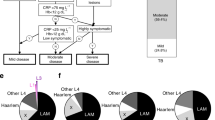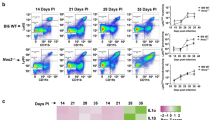Abstract
A central paradox of tuberculosis immunity is that reinfection and bacterial persistence occur despite vigorous host immune responses concentrated in granulomas, which are organized structures that form in response to infection. Prevailing models attribute reinfection and persistence to bacterial avoidance of host immunity via establishment of infection outside primary granulomas. Alternatively, persistence is attributed to a gradual bacterial adaptation to evolving host immune responses. We show here that superinfecting Mycobacterium marinum traffic rapidly into preexisting granulomas, including their caseous (necrotic) centers, through specific mycobacterium-directed and host cell–mediated processes, yet adapt quickly to persist long term therein. These findings demonstrate a failure of established granulomas, concentrated foci of activated macrophages and antigen-specific immune effector cells, to eradicate newly deposited mycobacteria not previously exposed to host responses.
This is a preview of subscription content, access via your institution
Access options
Subscribe to this journal
Receive 12 print issues and online access
$209.00 per year
only $17.42 per issue
Buy this article
- Purchase on Springer Link
- Instant access to full article PDF
Prices may be subject to local taxes which are calculated during checkout








Similar content being viewed by others
References
Parrish, N.M., Dick, J.D. & Bishai, W.R. Mechanisms of latency in Mycobacterium tuberculosis. Trends Microbiol. 6, 107–112 (1998).
Flynn, J.L. & Chan, J. Immunology of tuberculosis. Annu. Rev. Immunol. 19, 93–129 (2001).
Cosma, C.L., Sherman, D.R. & Ramakrishnan, L. The secret lives of the pathogenic mycobacteria. Annu. Rev. Microbiol. 57, 641–676 (2003).
Stead, W.W. Pathogenesis of a first episode of chronic pulmonary tuberculosis in man: recrudescence of residuals of the primary infection or exogenous reinfection? Am. Rev. Respir. Dis. 95, 729–745 (1967).
Caminero, J.A. et al. Exogenous reinfection with tuberculosis on a European island with a moderate incidence of disease. Am. J. Respir. Crit. Care Med. 163, 717–720 (2001).
van Rie, A. et al. Exogenous reinfection as a cause of recurrent tuberculosis after curative treatment. N. Engl. J. Med. 341, 1174–1179 (1999).
Kaufmann, S.H. How can immunology contribute to the control of tuberculosis? Nat. Rev. Immunol. 1, 20–30 (2001).
Sambandamurthy, V.K. et al. A pantothenate auxotroph of Mycobacterium tuberculosis is highly attenuated and protects mice against tuberculosis. Nat. Med. 8, 1171–1174 (2002).
Pym, A.S. et al. Recombinant BCG exporting ESAT-6 confers enhanced protection against tuberculosis. Nat. Med. 9, 533–539 (2003).
Grosset, J. Mycobacterium tuberculosis in the extracellular compartment: an underestimated adversary. Antimicrob. Agents Chemother. 47, 833–836 (2003).
Dannenberg, A.M., Jr. Immunopathogenesis of pulmonary tuberculosis. Hosp. Pract. 28, 51–58 (1993).
Lawn, S.D., Butera, S.T. & Shinnick, T.M. Tuberculosis unleashed: the impact of human immunodeficiency virus infection on the host granulomatous response to Mycobacterium tuberculosis. Microbes Infect. 4, 635–646 (2002).
Frieden, T.R., Sterling, T.R., Munsiff, S.S., Watt, C.J. & Dye, C. Tuberculosis. Lancet 362, 887–899 (2003).
Dannenberg, A.M., Jr. Macrophage turnover, division and activation within developing, peak and “healed” tuberculous lesions produced in rabbits by BCG. Tuberculosis (Edinb). 83, 251–260 (2003).
Hernandez-Pando, R. et al. Persistence of DNA from Mycobacterium tuberculosis in superficially normal lung tissue during latent infection. Lancet 356, 2133–2138 (2000).
Balasubramanian, V., Wiegeshaus, E.H., Taylor, B.T. & Smith, D.W. Pathogenesis of tuberculosis: pathway to apical localization. Tuber. Lung Dis. 75, 168–178 (1994).
McMurray, D.N. Hematogenous reseeding of the lung in low-dose, aerosol-infected guinea pigs: unique features of the host-pathogen interface in secondary tubercles. Tuberculosis (Edinb). 83, 131–134 (2003).
Opie, E.L. & Aronson, J.D. Tubercle bacilli in latent tuberculous lesions and in lung tissue without tuberculous lesions. Arch. Pathol. Lab. Med. 4, 1–21 (1927).
Ramakrishnan, L., Valdivia, R.H., McKerrow, J.H. & Falkow, S. Mycobacterium marinum causes both long-term subclinical infection and acute disease in the leopard frog (Rana pipiens). Infect. Immun. 65, 767–773 (1997).
Ramakrishnan, L. Using Mycobacterium marinum and its hosts to study tuberculosis. Curr. Sci. 86, 82–92 (2004).
Talaat, A.M., Reimschuessel, R., Wasserman, S.S. & Trucksis, M. Goldfish, Carassius auratus, a novel animal model for the study of Mycobacterium marinum pathogenesis. Infect. Immun. 66, 2938–2942 (1998).
Traver, D. et al. The zebrafish as a model organism to study development of the immune system. Adv. Immunol. 81, 253–330 (2003).
Chan, K. et al. Complex pattern of Mycobacterium marinum gene expression during long- term granulomatous infection. Proc. Natl. Acad. Sci. USA 99, 3920–3925 (2002).
Davis, J.M. et al. Real-time visualization of Mycobacterium-macrophage interactions leading to initiation of granuloma formation in zebrafish embryos. Immunity 17, 693–702 (2002).
Bouley, D.M., Ghori, N., Mercer, K.L., Falkow, S. & Ramakrishnan, L. Dynamic nature of host-pathogen interactions in Mycobacterium marinum granulomas. Infect. Immun. 69, 7820–7831 (2001).
Ramakrishnan, L., Federspiel, N.A. & Falkow, S. Granuloma-specific expression of Mycobacterium virulence proteins from the glycine-rich PE-PGRS family. Science 288, 1436–1439 (2000).
Gao, L.Y. et al. Requirement for kasB in Mycobacterium mycolic acid biosynthesis, cell wall impermeability and intracellular survival: implications for therapy. Mol. Microbiol. 49, 1547–1563 (2003).
Stamm, L.M. et al. Mycobacterium marinum escapes from phagosomes and is propelled by actin-based motility. J. Exp. Med. 198, 1361–1368 (2003).
Ohl, M.E. & Miller, S.I. Salmonella: A model for bacterial pathogenesis. Annu. Rev. Med. 52, 259–274 (2001).
Repique, C.J., Li, A., Collins, F.M. & Morris, S.L. DNA immunization in a mouse model of latent tuberculosis: effect of DNA vaccination on reactivation of disease and on reinfection with a secondary challenge. Infect. Immun. 70, 3318–3323 (2002).
Ziegler, J.E., Edwards, M.L. & Smith, D.W. Exogenous reinfection in experimental airborne tuberculosis. Tubercle 66, 121–128 (1985).
Tailleux, L. et al. DC-SIGN is the major Mycobacterium tuberculosis receptor on human dendritic cells. J. Exp. Med. 197, 121–127 (2003).
Teitelbaum, R. et al. The M cell as a portal of entry to the lung for the bacterial pathogen Mycobacterium tuberculosis. Immunity 10, 641–650 (1999).
Geijtenbeek, T.B. et al. Mycobacteria target DC-SIGN to suppress dendritic cell function. J. Exp. Med. 197, 7–17 (2003).
Roach, D.R., Briscoe, H., Baumgart, K., Rathjen, D.A. & Britton, W.J. Tumor necrosis factor (TNF) and a TNF-mimetic peptide modulate the granulomatous response to Mycobacterium bovis BCG infection in vivo. Infect. Immun. 67, 5473–5476. (1999).
Richter-Dahlfors, A., Buchan, A.M. & Finlay, B.B. Murine salmonellosis studied by confocal microscopy: Salmonella typhimurium resides intracellularly inside macrophages and exerts a cytotoxic effect on phagocytes in vivo. J. Exp. Med. 186, 569–580 (1997).
Janeway, C.A., Travers, P., Walport, M. & Shlomchik, M. Immunobiology (Garland Publishing, New York, 2001).
Rhoades, E.R., Frank, A.A. & Orme, I.M. Progression of chronic pulmonary tuberculosis in mice aerogenically infected with virulent Mycobacterium tuberculosis. Tuber. Lung Dis. 78, 57–66 (1997).
von Andrian, U.H. & Mempel, T.R. Homing and cellular traffic in lymph nodes. Nat. Rev. Immunol. 3, 867–878 (2003).
Adams, D.O. The granulomatous inflammatory response. A review. Am. J. Pathol. 84, 164–191 (1976).
Wayne, L.G. & Sohaskey, C.D. Nonreplicating persistence of Mycobacterium tuberculosis. Annu. Rev. Microbiol. 55, 139–163 (2001).
Fenhalls, G. et al. In situ detection of Mycobacterium tuberculosis transcripts in human lung granulomas reveals differential gene expression in necrotic lesions. Infect. Immun. 70, 6330–6338 (2002).
Belkaid, Y., Piccirillo, C.A., Mendez, S., Shevach, E.M. & Sacks, D.L. CD4+CD25+ regulatory T cells control Leishmania major persistence and immunity. Nature 420, 502–507 (2002).
Wherry, E.J., Blattman, J.N., Murali-Krishna, K., van der Most, R. & Ahmed, R. Viral persistence alters CD8 T-cell immunodominance and tissue distribution and results in distinct stages of functional impairment. J. Virol. 77, 4911–4927 (2003).
Acknowledgements
We thank K. Klein for technical assistance; K. Klein and P. Carroll for constructing plasmids; K. Urdahl, S. Miller, D. Sherman, M. Kaja, C. Wilson, M. Bevan and N. Salama for discussions; A. Farr and J. Dooley for tissue cryosectioning advice and equipment; D. Lauman for advice on statistics; and K. Urdahl, M. Kaja, T. Pozos and D. Tobin for comments on the manuscript. Supported by National Institutes of Health (R01 AI 36396) and an Ellison Medical Foundation New Scholar in Global Infectious Diseases award (L.R.).
Author information
Authors and Affiliations
Corresponding author
Ethics declarations
Competing interests
The authors declare no competing financial interests.
Supplementary information
Supplementary Table 1
Distribution of primary- and secondary-infecting M. marinum in frog tissues 3 days after secondary infection. (PDF 87 kb)
Supplementary Table 2
S. arizonae is no longer within established M. marinum granulomas by seven days after superinfection. (PDF 105 kb)
Rights and permissions
About this article
Cite this article
Cosma, C., Humbert, O. & Ramakrishnan, L. Superinfecting mycobacteria home to established tuberculous granulomas. Nat Immunol 5, 828–835 (2004). https://doi.org/10.1038/ni1091
Received:
Accepted:
Published:
Issue Date:
DOI: https://doi.org/10.1038/ni1091
This article is cited by
-
Integrity of the Actin Cytoskeleton of Host Macrophages is Necessary for Mycobacterial Entry
The Journal of Membrane Biology (2022)
-
Heme oxygenase-1 inhibition promotes IFNγ- and NOS2-mediated control of Mycobacterium tuberculosis infection
Mucosal Immunology (2021)
-
Active nuclear transcriptome analysis reveals inflammasome-dependent mechanism for early neutrophil response to Mycobacterium marinum
Scientific Reports (2017)
-
Protection and pathology in TB: learning from the zebrafish model
Seminars in Immunopathology (2016)
-
Etiologies of Sarcoidosis
Clinical Reviews in Allergy & Immunology (2015)



